HLTSC1000 Report: Emerging Mobile Stroke Unit Technology in Healthcare
VerifiedAdded on 2023/06/04
|14
|3777
|255
Report
AI Summary
This report examines the emerging technology of mobile stroke units and their potential to improve healthcare outcomes for stroke patients. It highlights the critical importance of timely treatment within the first three hours of a stroke, known as the "golden hour," to prevent long-term disabilities and save lives. The report analyzes the reasons healthcare needs this technology, outlining implementation procedures, potential risks of not adopting it, stakeholder planning, and the social impact. Mobile stroke units, equipped with specialized staff, portable CT scanners, and telemedicine capabilities, enable rapid diagnosis and treatment initiation, potentially reducing long-term healthcare costs and improving patients' quality of life. The report emphasizes the need for healthcare organizations to consider the benefits of mobile stroke units in improving stroke care and patient outcomes.
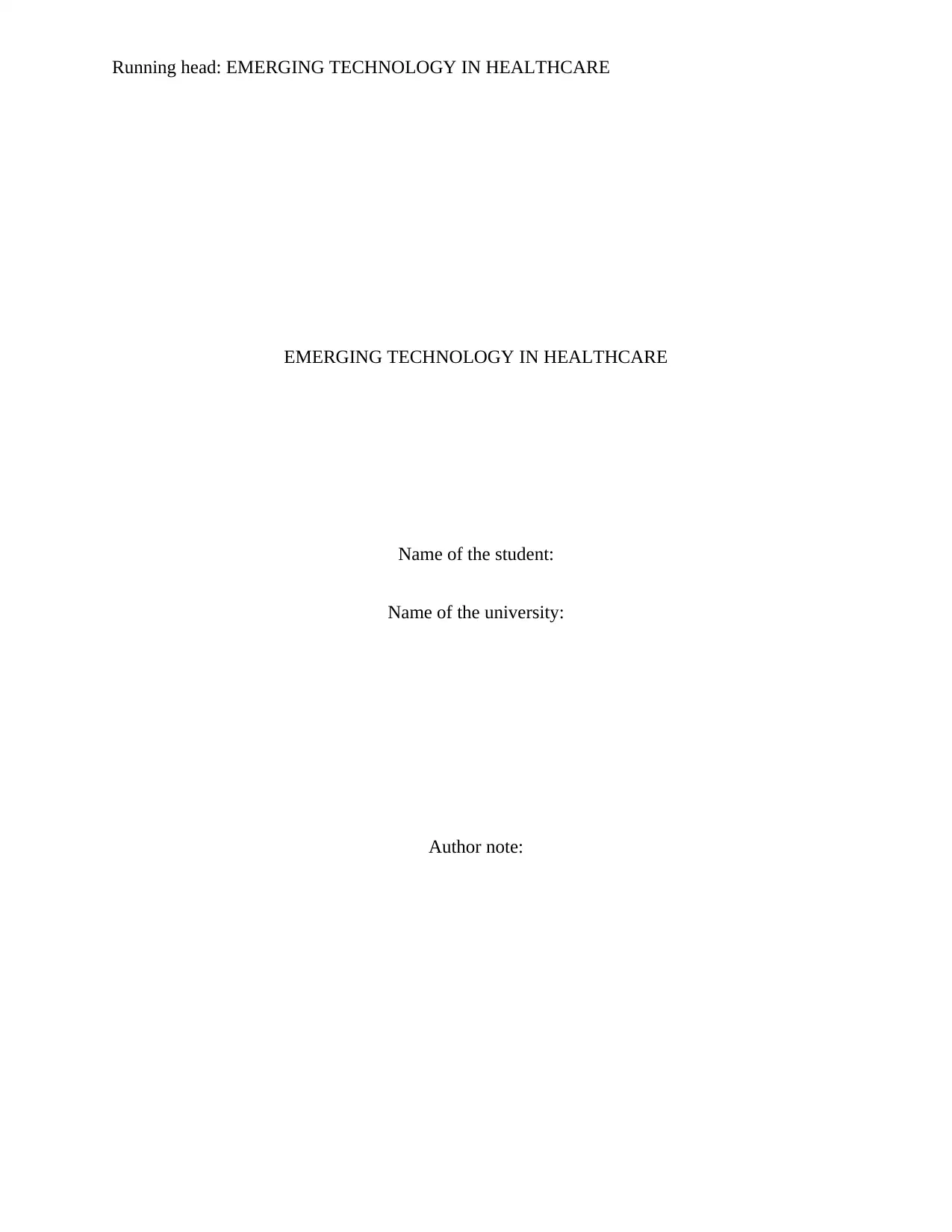
Running head: EMERGING TECHNOLOGY IN HEALTHCARE
EMERGING TECHNOLOGY IN HEALTHCARE
Name of the student:
Name of the university:
Author note:
EMERGING TECHNOLOGY IN HEALTHCARE
Name of the student:
Name of the university:
Author note:
Paraphrase This Document
Need a fresh take? Get an instant paraphrase of this document with our AI Paraphraser
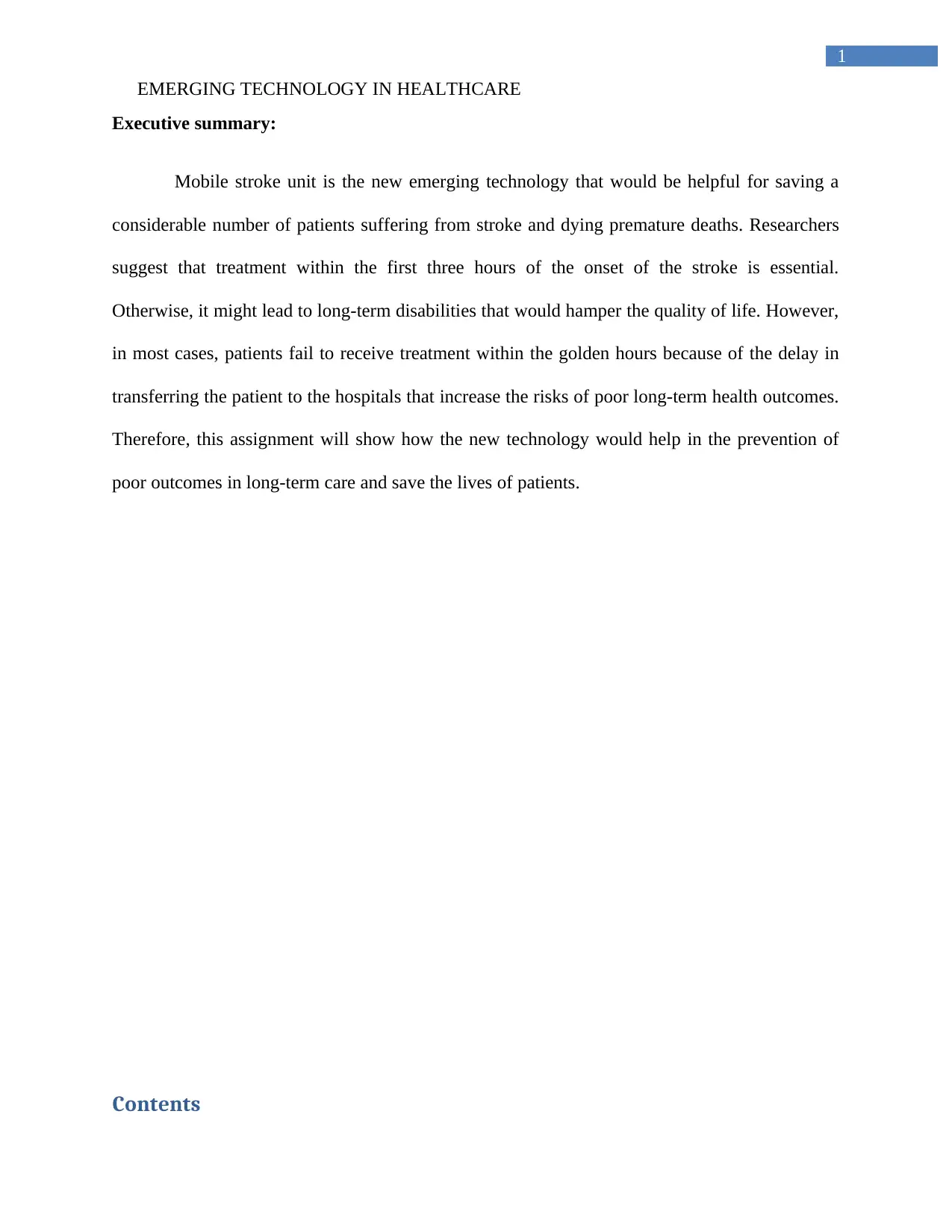
1
EMERGING TECHNOLOGY IN HEALTHCARE
Executive summary:
Mobile stroke unit is the new emerging technology that would be helpful for saving a
considerable number of patients suffering from stroke and dying premature deaths. Researchers
suggest that treatment within the first three hours of the onset of the stroke is essential.
Otherwise, it might lead to long-term disabilities that would hamper the quality of life. However,
in most cases, patients fail to receive treatment within the golden hours because of the delay in
transferring the patient to the hospitals that increase the risks of poor long-term health outcomes.
Therefore, this assignment will show how the new technology would help in the prevention of
poor outcomes in long-term care and save the lives of patients.
Contents
EMERGING TECHNOLOGY IN HEALTHCARE
Executive summary:
Mobile stroke unit is the new emerging technology that would be helpful for saving a
considerable number of patients suffering from stroke and dying premature deaths. Researchers
suggest that treatment within the first three hours of the onset of the stroke is essential.
Otherwise, it might lead to long-term disabilities that would hamper the quality of life. However,
in most cases, patients fail to receive treatment within the golden hours because of the delay in
transferring the patient to the hospitals that increase the risks of poor long-term health outcomes.
Therefore, this assignment will show how the new technology would help in the prevention of
poor outcomes in long-term care and save the lives of patients.
Contents
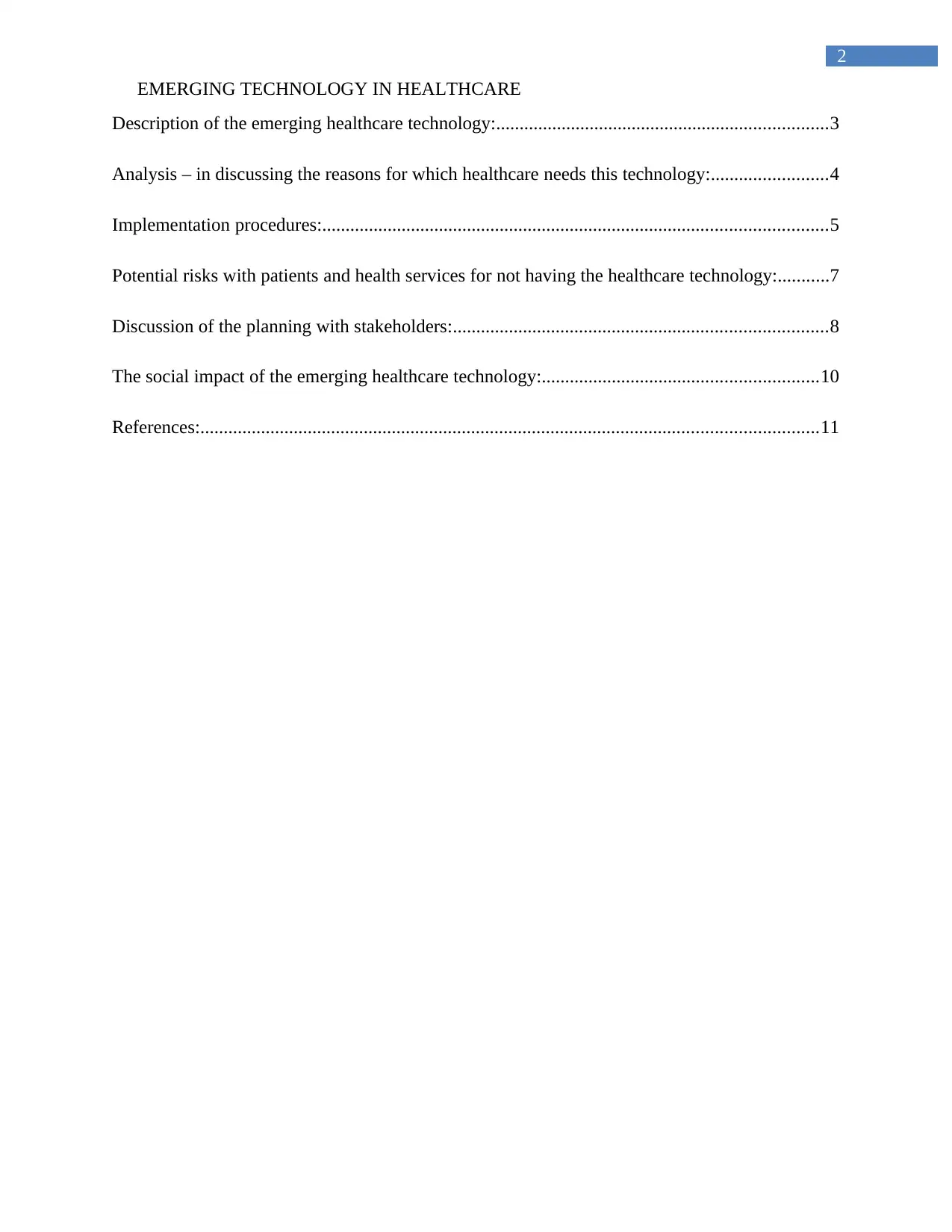
2
EMERGING TECHNOLOGY IN HEALTHCARE
Description of the emerging healthcare technology:.......................................................................3
Analysis – in discussing the reasons for which healthcare needs this technology:.........................4
Implementation procedures:............................................................................................................5
Potential risks with patients and health services for not having the healthcare technology:...........7
Discussion of the planning with stakeholders:................................................................................8
The social impact of the emerging healthcare technology:...........................................................10
References:....................................................................................................................................11
EMERGING TECHNOLOGY IN HEALTHCARE
Description of the emerging healthcare technology:.......................................................................3
Analysis – in discussing the reasons for which healthcare needs this technology:.........................4
Implementation procedures:............................................................................................................5
Potential risks with patients and health services for not having the healthcare technology:...........7
Discussion of the planning with stakeholders:................................................................................8
The social impact of the emerging healthcare technology:...........................................................10
References:....................................................................................................................................11
⊘ This is a preview!⊘
Do you want full access?
Subscribe today to unlock all pages.

Trusted by 1+ million students worldwide
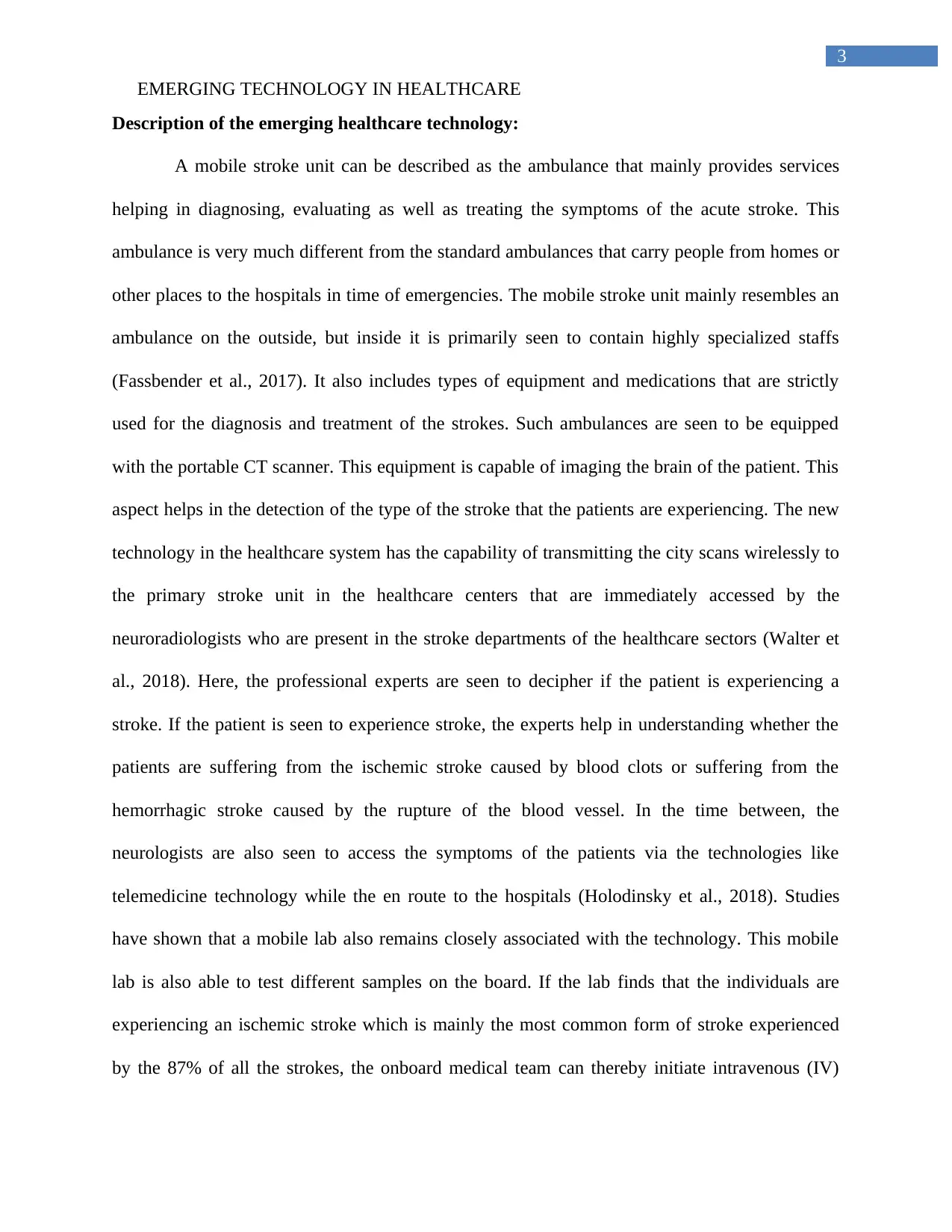
3
EMERGING TECHNOLOGY IN HEALTHCARE
Description of the emerging healthcare technology:
A mobile stroke unit can be described as the ambulance that mainly provides services
helping in diagnosing, evaluating as well as treating the symptoms of the acute stroke. This
ambulance is very much different from the standard ambulances that carry people from homes or
other places to the hospitals in time of emergencies. The mobile stroke unit mainly resembles an
ambulance on the outside, but inside it is primarily seen to contain highly specialized staffs
(Fassbender et al., 2017). It also includes types of equipment and medications that are strictly
used for the diagnosis and treatment of the strokes. Such ambulances are seen to be equipped
with the portable CT scanner. This equipment is capable of imaging the brain of the patient. This
aspect helps in the detection of the type of the stroke that the patients are experiencing. The new
technology in the healthcare system has the capability of transmitting the city scans wirelessly to
the primary stroke unit in the healthcare centers that are immediately accessed by the
neuroradiologists who are present in the stroke departments of the healthcare sectors (Walter et
al., 2018). Here, the professional experts are seen to decipher if the patient is experiencing a
stroke. If the patient is seen to experience stroke, the experts help in understanding whether the
patients are suffering from the ischemic stroke caused by blood clots or suffering from the
hemorrhagic stroke caused by the rupture of the blood vessel. In the time between, the
neurologists are also seen to access the symptoms of the patients via the technologies like
telemedicine technology while the en route to the hospitals (Holodinsky et al., 2018). Studies
have shown that a mobile lab also remains closely associated with the technology. This mobile
lab is also able to test different samples on the board. If the lab finds that the individuals are
experiencing an ischemic stroke which is mainly the most common form of stroke experienced
by the 87% of all the strokes, the onboard medical team can thereby initiate intravenous (IV)
EMERGING TECHNOLOGY IN HEALTHCARE
Description of the emerging healthcare technology:
A mobile stroke unit can be described as the ambulance that mainly provides services
helping in diagnosing, evaluating as well as treating the symptoms of the acute stroke. This
ambulance is very much different from the standard ambulances that carry people from homes or
other places to the hospitals in time of emergencies. The mobile stroke unit mainly resembles an
ambulance on the outside, but inside it is primarily seen to contain highly specialized staffs
(Fassbender et al., 2017). It also includes types of equipment and medications that are strictly
used for the diagnosis and treatment of the strokes. Such ambulances are seen to be equipped
with the portable CT scanner. This equipment is capable of imaging the brain of the patient. This
aspect helps in the detection of the type of the stroke that the patients are experiencing. The new
technology in the healthcare system has the capability of transmitting the city scans wirelessly to
the primary stroke unit in the healthcare centers that are immediately accessed by the
neuroradiologists who are present in the stroke departments of the healthcare sectors (Walter et
al., 2018). Here, the professional experts are seen to decipher if the patient is experiencing a
stroke. If the patient is seen to experience stroke, the experts help in understanding whether the
patients are suffering from the ischemic stroke caused by blood clots or suffering from the
hemorrhagic stroke caused by the rupture of the blood vessel. In the time between, the
neurologists are also seen to access the symptoms of the patients via the technologies like
telemedicine technology while the en route to the hospitals (Holodinsky et al., 2018). Studies
have shown that a mobile lab also remains closely associated with the technology. This mobile
lab is also able to test different samples on the board. If the lab finds that the individuals are
experiencing an ischemic stroke which is mainly the most common form of stroke experienced
by the 87% of all the strokes, the onboard medical team can thereby initiate intravenous (IV)
Paraphrase This Document
Need a fresh take? Get an instant paraphrase of this document with our AI Paraphraser
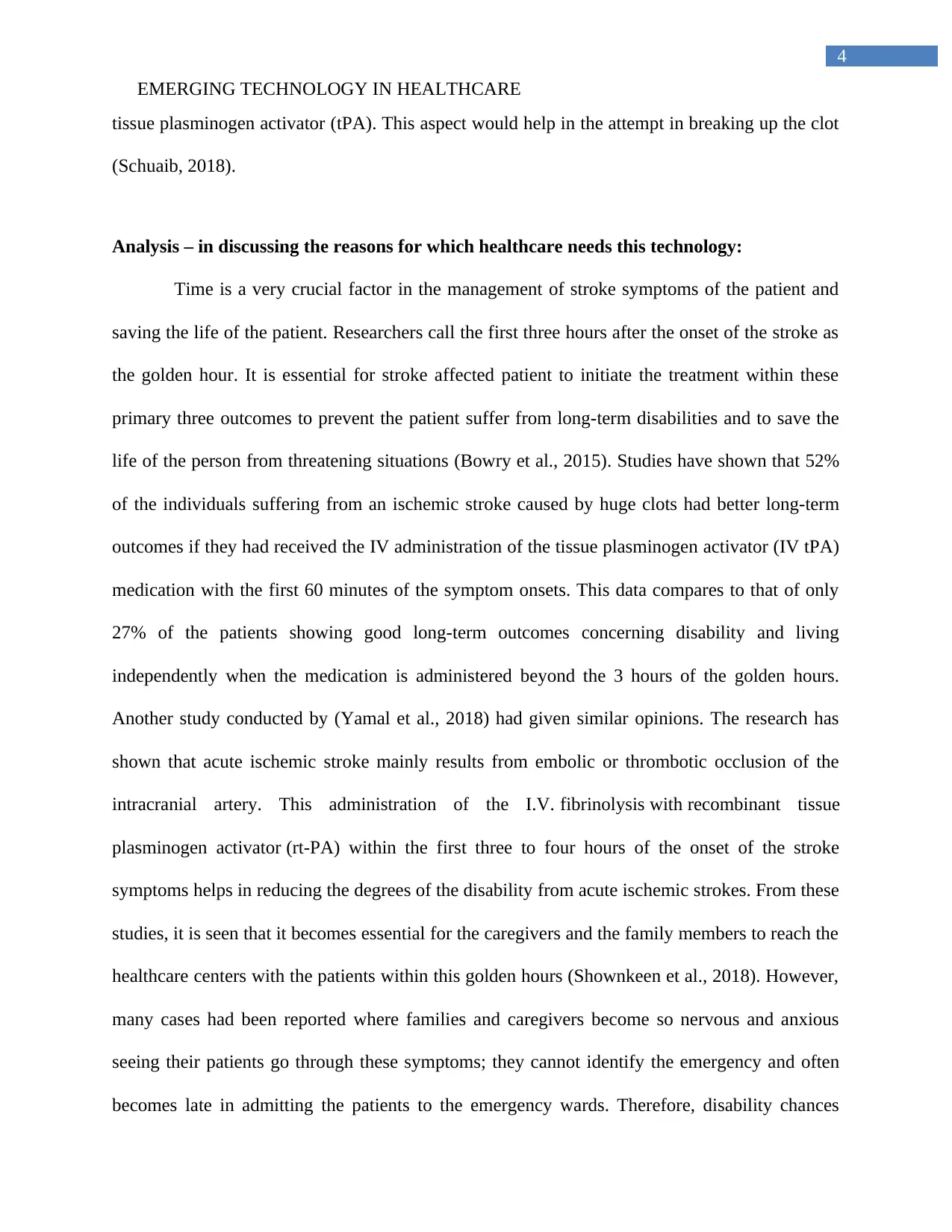
4
EMERGING TECHNOLOGY IN HEALTHCARE
tissue plasminogen activator (tPA). This aspect would help in the attempt in breaking up the clot
(Schuaib, 2018).
Analysis – in discussing the reasons for which healthcare needs this technology:
Time is a very crucial factor in the management of stroke symptoms of the patient and
saving the life of the patient. Researchers call the first three hours after the onset of the stroke as
the golden hour. It is essential for stroke affected patient to initiate the treatment within these
primary three outcomes to prevent the patient suffer from long-term disabilities and to save the
life of the person from threatening situations (Bowry et al., 2015). Studies have shown that 52%
of the individuals suffering from an ischemic stroke caused by huge clots had better long-term
outcomes if they had received the IV administration of the tissue plasminogen activator (IV tPA)
medication with the first 60 minutes of the symptom onsets. This data compares to that of only
27% of the patients showing good long-term outcomes concerning disability and living
independently when the medication is administered beyond the 3 hours of the golden hours.
Another study conducted by (Yamal et al., 2018) had given similar opinions. The research has
shown that acute ischemic stroke mainly results from embolic or thrombotic occlusion of the
intracranial artery. This administration of the I.V. fibrinolysis with recombinant tissue
plasminogen activator (rt-PA) within the first three to four hours of the onset of the stroke
symptoms helps in reducing the degrees of the disability from acute ischemic strokes. From these
studies, it is seen that it becomes essential for the caregivers and the family members to reach the
healthcare centers with the patients within this golden hours (Shownkeen et al., 2018). However,
many cases had been reported where families and caregivers become so nervous and anxious
seeing their patients go through these symptoms; they cannot identify the emergency and often
becomes late in admitting the patients to the emergency wards. Therefore, disability chances
EMERGING TECHNOLOGY IN HEALTHCARE
tissue plasminogen activator (tPA). This aspect would help in the attempt in breaking up the clot
(Schuaib, 2018).
Analysis – in discussing the reasons for which healthcare needs this technology:
Time is a very crucial factor in the management of stroke symptoms of the patient and
saving the life of the patient. Researchers call the first three hours after the onset of the stroke as
the golden hour. It is essential for stroke affected patient to initiate the treatment within these
primary three outcomes to prevent the patient suffer from long-term disabilities and to save the
life of the person from threatening situations (Bowry et al., 2015). Studies have shown that 52%
of the individuals suffering from an ischemic stroke caused by huge clots had better long-term
outcomes if they had received the IV administration of the tissue plasminogen activator (IV tPA)
medication with the first 60 minutes of the symptom onsets. This data compares to that of only
27% of the patients showing good long-term outcomes concerning disability and living
independently when the medication is administered beyond the 3 hours of the golden hours.
Another study conducted by (Yamal et al., 2018) had given similar opinions. The research has
shown that acute ischemic stroke mainly results from embolic or thrombotic occlusion of the
intracranial artery. This administration of the I.V. fibrinolysis with recombinant tissue
plasminogen activator (rt-PA) within the first three to four hours of the onset of the stroke
symptoms helps in reducing the degrees of the disability from acute ischemic strokes. From these
studies, it is seen that it becomes essential for the caregivers and the family members to reach the
healthcare centers with the patients within this golden hours (Shownkeen et al., 2018). However,
many cases had been reported where families and caregivers become so nervous and anxious
seeing their patients go through these symptoms; they cannot identify the emergency and often
becomes late in admitting the patients to the emergency wards. Therefore, disability chances
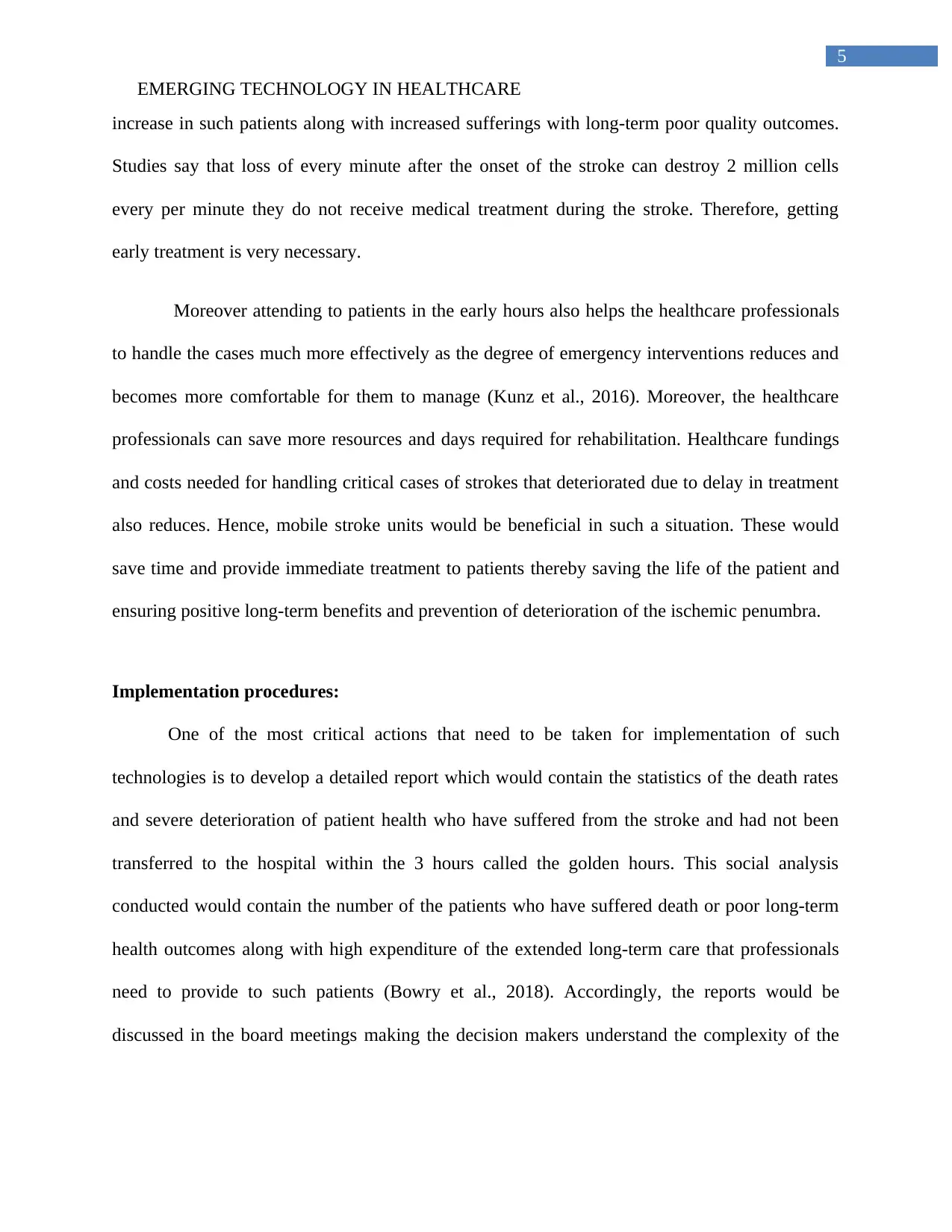
5
EMERGING TECHNOLOGY IN HEALTHCARE
increase in such patients along with increased sufferings with long-term poor quality outcomes.
Studies say that loss of every minute after the onset of the stroke can destroy 2 million cells
every per minute they do not receive medical treatment during the stroke. Therefore, getting
early treatment is very necessary.
Moreover attending to patients in the early hours also helps the healthcare professionals
to handle the cases much more effectively as the degree of emergency interventions reduces and
becomes more comfortable for them to manage (Kunz et al., 2016). Moreover, the healthcare
professionals can save more resources and days required for rehabilitation. Healthcare fundings
and costs needed for handling critical cases of strokes that deteriorated due to delay in treatment
also reduces. Hence, mobile stroke units would be beneficial in such a situation. These would
save time and provide immediate treatment to patients thereby saving the life of the patient and
ensuring positive long-term benefits and prevention of deterioration of the ischemic penumbra.
Implementation procedures:
One of the most critical actions that need to be taken for implementation of such
technologies is to develop a detailed report which would contain the statistics of the death rates
and severe deterioration of patient health who have suffered from the stroke and had not been
transferred to the hospital within the 3 hours called the golden hours. This social analysis
conducted would contain the number of the patients who have suffered death or poor long-term
health outcomes along with high expenditure of the extended long-term care that professionals
need to provide to such patients (Bowry et al., 2018). Accordingly, the reports would be
discussed in the board meetings making the decision makers understand the complexity of the
EMERGING TECHNOLOGY IN HEALTHCARE
increase in such patients along with increased sufferings with long-term poor quality outcomes.
Studies say that loss of every minute after the onset of the stroke can destroy 2 million cells
every per minute they do not receive medical treatment during the stroke. Therefore, getting
early treatment is very necessary.
Moreover attending to patients in the early hours also helps the healthcare professionals
to handle the cases much more effectively as the degree of emergency interventions reduces and
becomes more comfortable for them to manage (Kunz et al., 2016). Moreover, the healthcare
professionals can save more resources and days required for rehabilitation. Healthcare fundings
and costs needed for handling critical cases of strokes that deteriorated due to delay in treatment
also reduces. Hence, mobile stroke units would be beneficial in such a situation. These would
save time and provide immediate treatment to patients thereby saving the life of the patient and
ensuring positive long-term benefits and prevention of deterioration of the ischemic penumbra.
Implementation procedures:
One of the most critical actions that need to be taken for implementation of such
technologies is to develop a detailed report which would contain the statistics of the death rates
and severe deterioration of patient health who have suffered from the stroke and had not been
transferred to the hospital within the 3 hours called the golden hours. This social analysis
conducted would contain the number of the patients who have suffered death or poor long-term
health outcomes along with high expenditure of the extended long-term care that professionals
need to provide to such patients (Bowry et al., 2018). Accordingly, the reports would be
discussed in the board meetings making the decision makers understand the complexity of the
⊘ This is a preview!⊘
Do you want full access?
Subscribe today to unlock all pages.

Trusted by 1+ million students worldwide
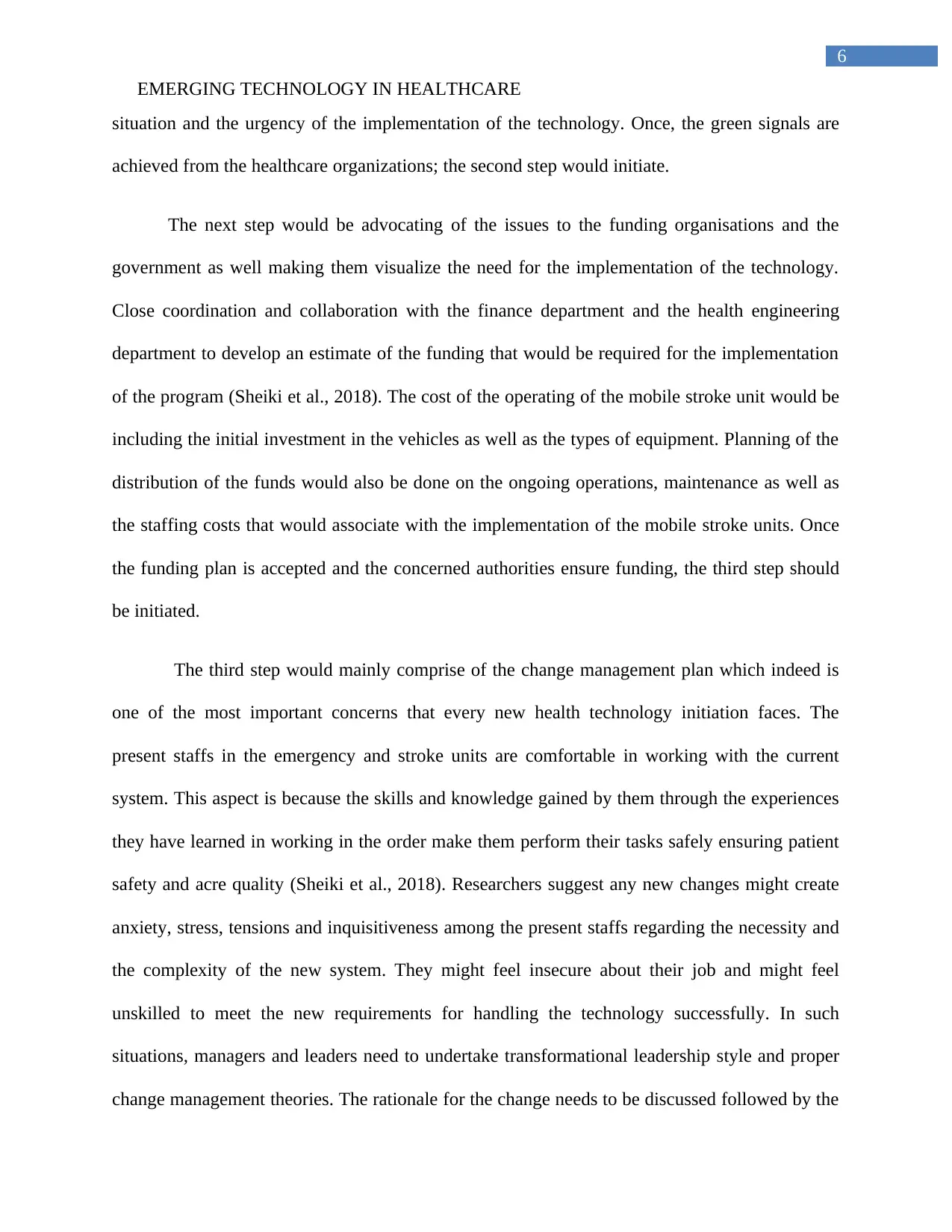
6
EMERGING TECHNOLOGY IN HEALTHCARE
situation and the urgency of the implementation of the technology. Once, the green signals are
achieved from the healthcare organizations; the second step would initiate.
The next step would be advocating of the issues to the funding organisations and the
government as well making them visualize the need for the implementation of the technology.
Close coordination and collaboration with the finance department and the health engineering
department to develop an estimate of the funding that would be required for the implementation
of the program (Sheiki et al., 2018). The cost of the operating of the mobile stroke unit would be
including the initial investment in the vehicles as well as the types of equipment. Planning of the
distribution of the funds would also be done on the ongoing operations, maintenance as well as
the staffing costs that would associate with the implementation of the mobile stroke units. Once
the funding plan is accepted and the concerned authorities ensure funding, the third step should
be initiated.
The third step would mainly comprise of the change management plan which indeed is
one of the most important concerns that every new health technology initiation faces. The
present staffs in the emergency and stroke units are comfortable in working with the current
system. This aspect is because the skills and knowledge gained by them through the experiences
they have learned in working in the order make them perform their tasks safely ensuring patient
safety and acre quality (Sheiki et al., 2018). Researchers suggest any new changes might create
anxiety, stress, tensions and inquisitiveness among the present staffs regarding the necessity and
the complexity of the new system. They might feel insecure about their job and might feel
unskilled to meet the new requirements for handling the technology successfully. In such
situations, managers and leaders need to undertake transformational leadership style and proper
change management theories. The rationale for the change needs to be discussed followed by the
EMERGING TECHNOLOGY IN HEALTHCARE
situation and the urgency of the implementation of the technology. Once, the green signals are
achieved from the healthcare organizations; the second step would initiate.
The next step would be advocating of the issues to the funding organisations and the
government as well making them visualize the need for the implementation of the technology.
Close coordination and collaboration with the finance department and the health engineering
department to develop an estimate of the funding that would be required for the implementation
of the program (Sheiki et al., 2018). The cost of the operating of the mobile stroke unit would be
including the initial investment in the vehicles as well as the types of equipment. Planning of the
distribution of the funds would also be done on the ongoing operations, maintenance as well as
the staffing costs that would associate with the implementation of the mobile stroke units. Once
the funding plan is accepted and the concerned authorities ensure funding, the third step should
be initiated.
The third step would mainly comprise of the change management plan which indeed is
one of the most important concerns that every new health technology initiation faces. The
present staffs in the emergency and stroke units are comfortable in working with the current
system. This aspect is because the skills and knowledge gained by them through the experiences
they have learned in working in the order make them perform their tasks safely ensuring patient
safety and acre quality (Sheiki et al., 2018). Researchers suggest any new changes might create
anxiety, stress, tensions and inquisitiveness among the present staffs regarding the necessity and
the complexity of the new system. They might feel insecure about their job and might feel
unskilled to meet the new requirements for handling the technology successfully. In such
situations, managers and leaders need to undertake transformational leadership style and proper
change management theories. The rationale for the change needs to be discussed followed by the
Paraphrase This Document
Need a fresh take? Get an instant paraphrase of this document with our AI Paraphraser
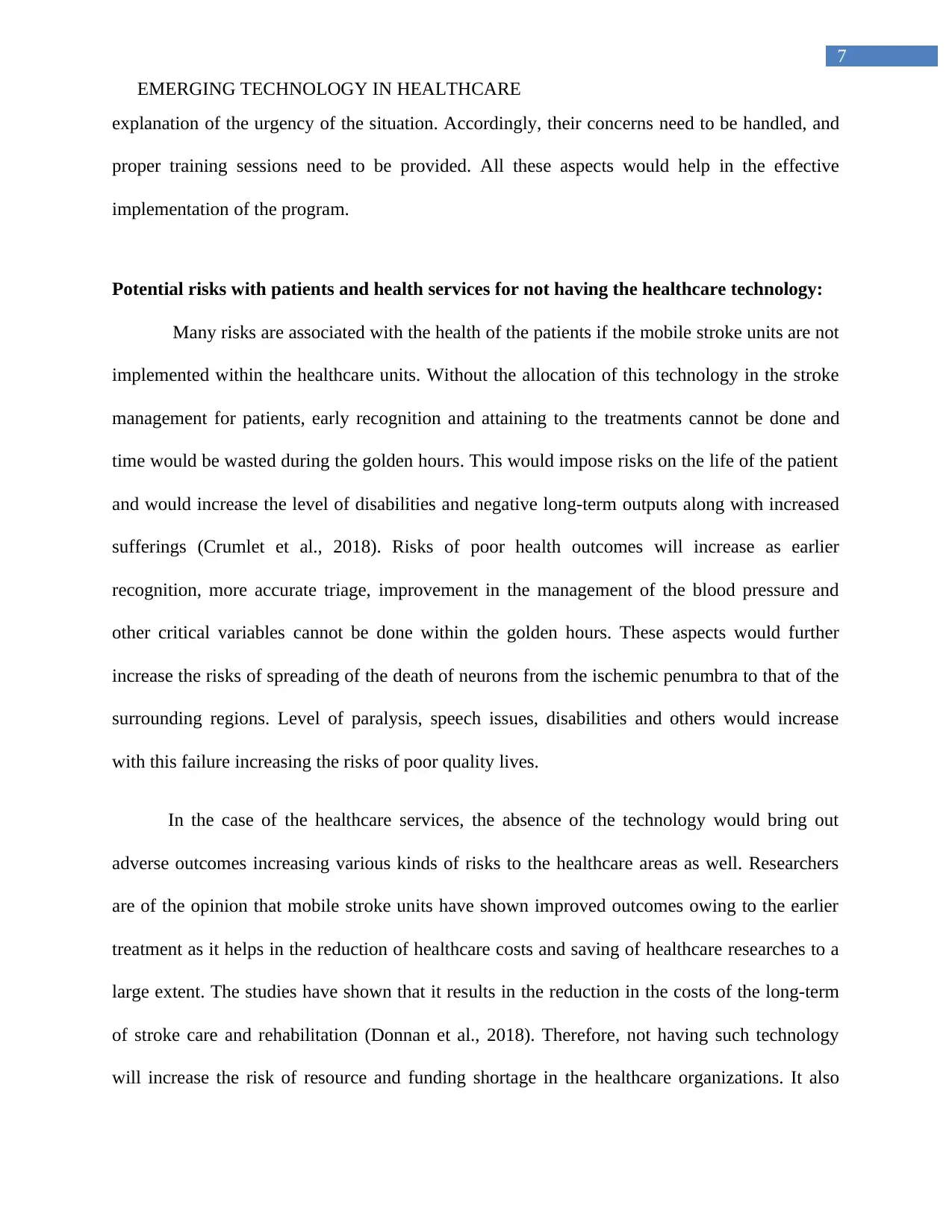
7
EMERGING TECHNOLOGY IN HEALTHCARE
explanation of the urgency of the situation. Accordingly, their concerns need to be handled, and
proper training sessions need to be provided. All these aspects would help in the effective
implementation of the program.
Potential risks with patients and health services for not having the healthcare technology:
Many risks are associated with the health of the patients if the mobile stroke units are not
implemented within the healthcare units. Without the allocation of this technology in the stroke
management for patients, early recognition and attaining to the treatments cannot be done and
time would be wasted during the golden hours. This would impose risks on the life of the patient
and would increase the level of disabilities and negative long-term outputs along with increased
sufferings (Crumlet et al., 2018). Risks of poor health outcomes will increase as earlier
recognition, more accurate triage, improvement in the management of the blood pressure and
other critical variables cannot be done within the golden hours. These aspects would further
increase the risks of spreading of the death of neurons from the ischemic penumbra to that of the
surrounding regions. Level of paralysis, speech issues, disabilities and others would increase
with this failure increasing the risks of poor quality lives.
In the case of the healthcare services, the absence of the technology would bring out
adverse outcomes increasing various kinds of risks to the healthcare areas as well. Researchers
are of the opinion that mobile stroke units have shown improved outcomes owing to the earlier
treatment as it helps in the reduction of healthcare costs and saving of healthcare researches to a
large extent. The studies have shown that it results in the reduction in the costs of the long-term
of stroke care and rehabilitation (Donnan et al., 2018). Therefore, not having such technology
will increase the risk of resource and funding shortage in the healthcare organizations. It also
EMERGING TECHNOLOGY IN HEALTHCARE
explanation of the urgency of the situation. Accordingly, their concerns need to be handled, and
proper training sessions need to be provided. All these aspects would help in the effective
implementation of the program.
Potential risks with patients and health services for not having the healthcare technology:
Many risks are associated with the health of the patients if the mobile stroke units are not
implemented within the healthcare units. Without the allocation of this technology in the stroke
management for patients, early recognition and attaining to the treatments cannot be done and
time would be wasted during the golden hours. This would impose risks on the life of the patient
and would increase the level of disabilities and negative long-term outputs along with increased
sufferings (Crumlet et al., 2018). Risks of poor health outcomes will increase as earlier
recognition, more accurate triage, improvement in the management of the blood pressure and
other critical variables cannot be done within the golden hours. These aspects would further
increase the risks of spreading of the death of neurons from the ischemic penumbra to that of the
surrounding regions. Level of paralysis, speech issues, disabilities and others would increase
with this failure increasing the risks of poor quality lives.
In the case of the healthcare services, the absence of the technology would bring out
adverse outcomes increasing various kinds of risks to the healthcare areas as well. Researchers
are of the opinion that mobile stroke units have shown improved outcomes owing to the earlier
treatment as it helps in the reduction of healthcare costs and saving of healthcare researches to a
large extent. The studies have shown that it results in the reduction in the costs of the long-term
of stroke care and rehabilitation (Donnan et al., 2018). Therefore, not having such technology
will increase the risk of resource and funding shortage in the healthcare organizations. It also
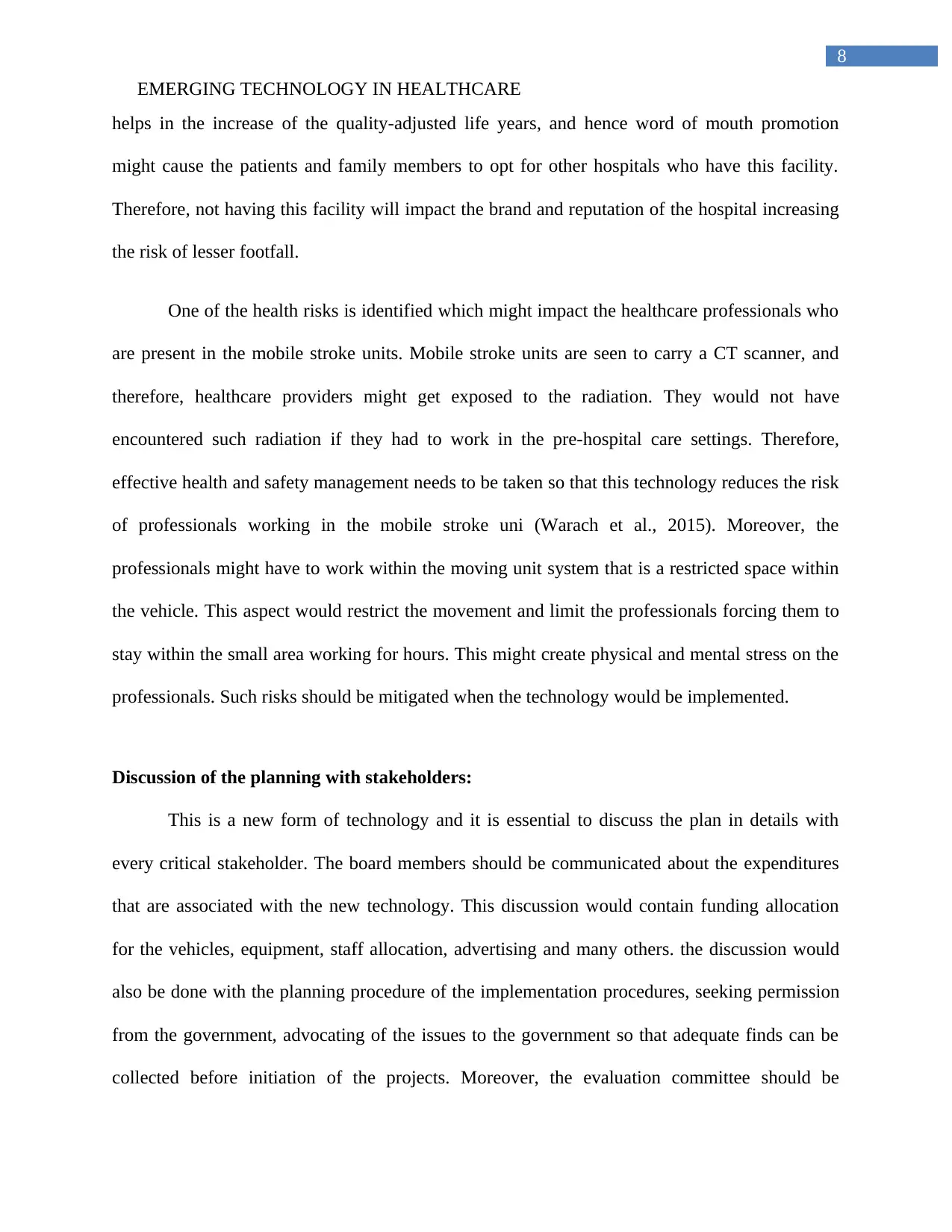
8
EMERGING TECHNOLOGY IN HEALTHCARE
helps in the increase of the quality-adjusted life years, and hence word of mouth promotion
might cause the patients and family members to opt for other hospitals who have this facility.
Therefore, not having this facility will impact the brand and reputation of the hospital increasing
the risk of lesser footfall.
One of the health risks is identified which might impact the healthcare professionals who
are present in the mobile stroke units. Mobile stroke units are seen to carry a CT scanner, and
therefore, healthcare providers might get exposed to the radiation. They would not have
encountered such radiation if they had to work in the pre-hospital care settings. Therefore,
effective health and safety management needs to be taken so that this technology reduces the risk
of professionals working in the mobile stroke uni (Warach et al., 2015). Moreover, the
professionals might have to work within the moving unit system that is a restricted space within
the vehicle. This aspect would restrict the movement and limit the professionals forcing them to
stay within the small area working for hours. This might create physical and mental stress on the
professionals. Such risks should be mitigated when the technology would be implemented.
Discussion of the planning with stakeholders:
This is a new form of technology and it is essential to discuss the plan in details with
every critical stakeholder. The board members should be communicated about the expenditures
that are associated with the new technology. This discussion would contain funding allocation
for the vehicles, equipment, staff allocation, advertising and many others. the discussion would
also be done with the planning procedure of the implementation procedures, seeking permission
from the government, advocating of the issues to the government so that adequate finds can be
collected before initiation of the projects. Moreover, the evaluation committee should be
EMERGING TECHNOLOGY IN HEALTHCARE
helps in the increase of the quality-adjusted life years, and hence word of mouth promotion
might cause the patients and family members to opt for other hospitals who have this facility.
Therefore, not having this facility will impact the brand and reputation of the hospital increasing
the risk of lesser footfall.
One of the health risks is identified which might impact the healthcare professionals who
are present in the mobile stroke units. Mobile stroke units are seen to carry a CT scanner, and
therefore, healthcare providers might get exposed to the radiation. They would not have
encountered such radiation if they had to work in the pre-hospital care settings. Therefore,
effective health and safety management needs to be taken so that this technology reduces the risk
of professionals working in the mobile stroke uni (Warach et al., 2015). Moreover, the
professionals might have to work within the moving unit system that is a restricted space within
the vehicle. This aspect would restrict the movement and limit the professionals forcing them to
stay within the small area working for hours. This might create physical and mental stress on the
professionals. Such risks should be mitigated when the technology would be implemented.
Discussion of the planning with stakeholders:
This is a new form of technology and it is essential to discuss the plan in details with
every critical stakeholder. The board members should be communicated about the expenditures
that are associated with the new technology. This discussion would contain funding allocation
for the vehicles, equipment, staff allocation, advertising and many others. the discussion would
also be done with the planning procedure of the implementation procedures, seeking permission
from the government, advocating of the issues to the government so that adequate finds can be
collected before initiation of the projects. Moreover, the evaluation committee should be
⊘ This is a preview!⊘
Do you want full access?
Subscribe today to unlock all pages.

Trusted by 1+ million students worldwide
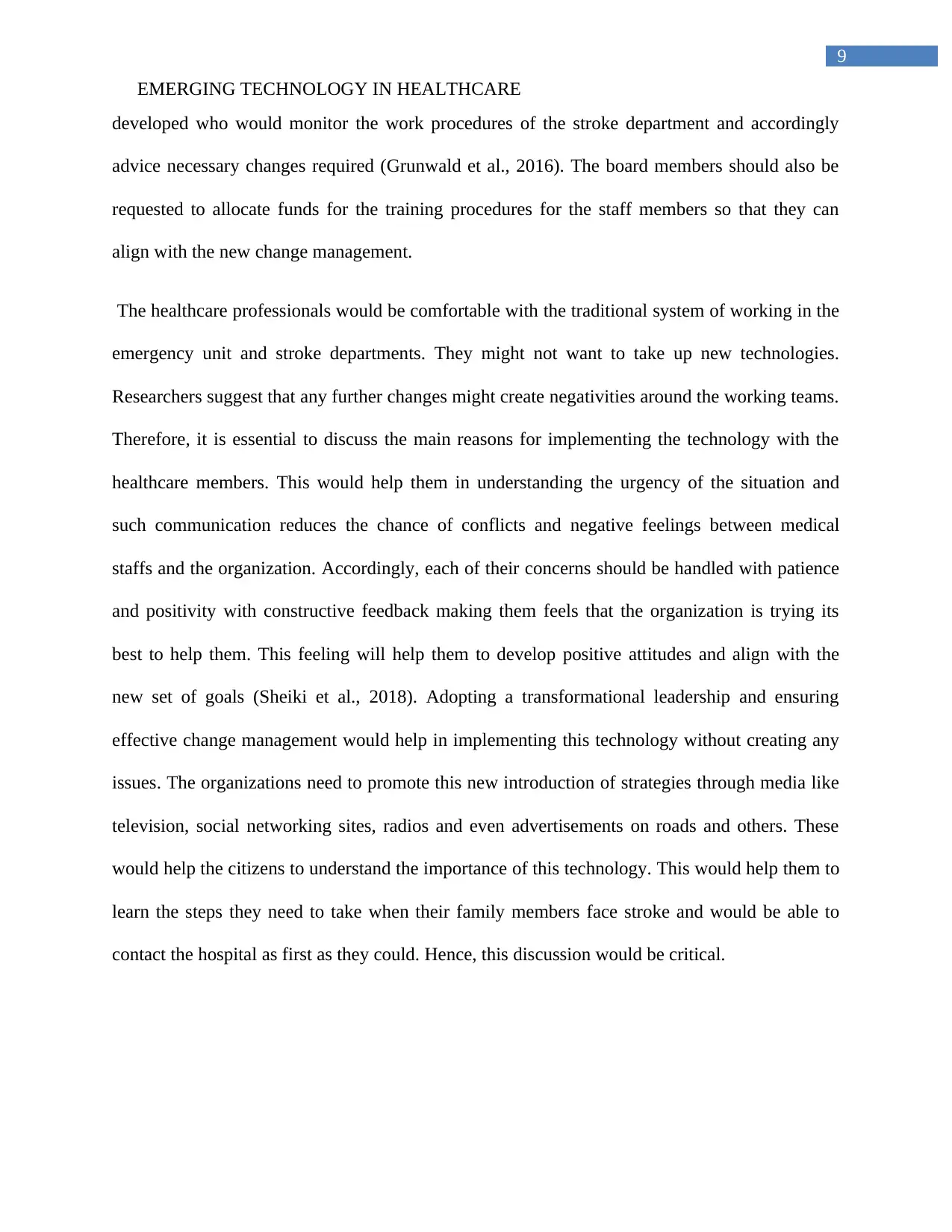
9
EMERGING TECHNOLOGY IN HEALTHCARE
developed who would monitor the work procedures of the stroke department and accordingly
advice necessary changes required (Grunwald et al., 2016). The board members should also be
requested to allocate funds for the training procedures for the staff members so that they can
align with the new change management.
The healthcare professionals would be comfortable with the traditional system of working in the
emergency unit and stroke departments. They might not want to take up new technologies.
Researchers suggest that any further changes might create negativities around the working teams.
Therefore, it is essential to discuss the main reasons for implementing the technology with the
healthcare members. This would help them in understanding the urgency of the situation and
such communication reduces the chance of conflicts and negative feelings between medical
staffs and the organization. Accordingly, each of their concerns should be handled with patience
and positivity with constructive feedback making them feels that the organization is trying its
best to help them. This feeling will help them to develop positive attitudes and align with the
new set of goals (Sheiki et al., 2018). Adopting a transformational leadership and ensuring
effective change management would help in implementing this technology without creating any
issues. The organizations need to promote this new introduction of strategies through media like
television, social networking sites, radios and even advertisements on roads and others. These
would help the citizens to understand the importance of this technology. This would help them to
learn the steps they need to take when their family members face stroke and would be able to
contact the hospital as first as they could. Hence, this discussion would be critical.
EMERGING TECHNOLOGY IN HEALTHCARE
developed who would monitor the work procedures of the stroke department and accordingly
advice necessary changes required (Grunwald et al., 2016). The board members should also be
requested to allocate funds for the training procedures for the staff members so that they can
align with the new change management.
The healthcare professionals would be comfortable with the traditional system of working in the
emergency unit and stroke departments. They might not want to take up new technologies.
Researchers suggest that any further changes might create negativities around the working teams.
Therefore, it is essential to discuss the main reasons for implementing the technology with the
healthcare members. This would help them in understanding the urgency of the situation and
such communication reduces the chance of conflicts and negative feelings between medical
staffs and the organization. Accordingly, each of their concerns should be handled with patience
and positivity with constructive feedback making them feels that the organization is trying its
best to help them. This feeling will help them to develop positive attitudes and align with the
new set of goals (Sheiki et al., 2018). Adopting a transformational leadership and ensuring
effective change management would help in implementing this technology without creating any
issues. The organizations need to promote this new introduction of strategies through media like
television, social networking sites, radios and even advertisements on roads and others. These
would help the citizens to understand the importance of this technology. This would help them to
learn the steps they need to take when their family members face stroke and would be able to
contact the hospital as first as they could. Hence, this discussion would be critical.
Paraphrase This Document
Need a fresh take? Get an instant paraphrase of this document with our AI Paraphraser
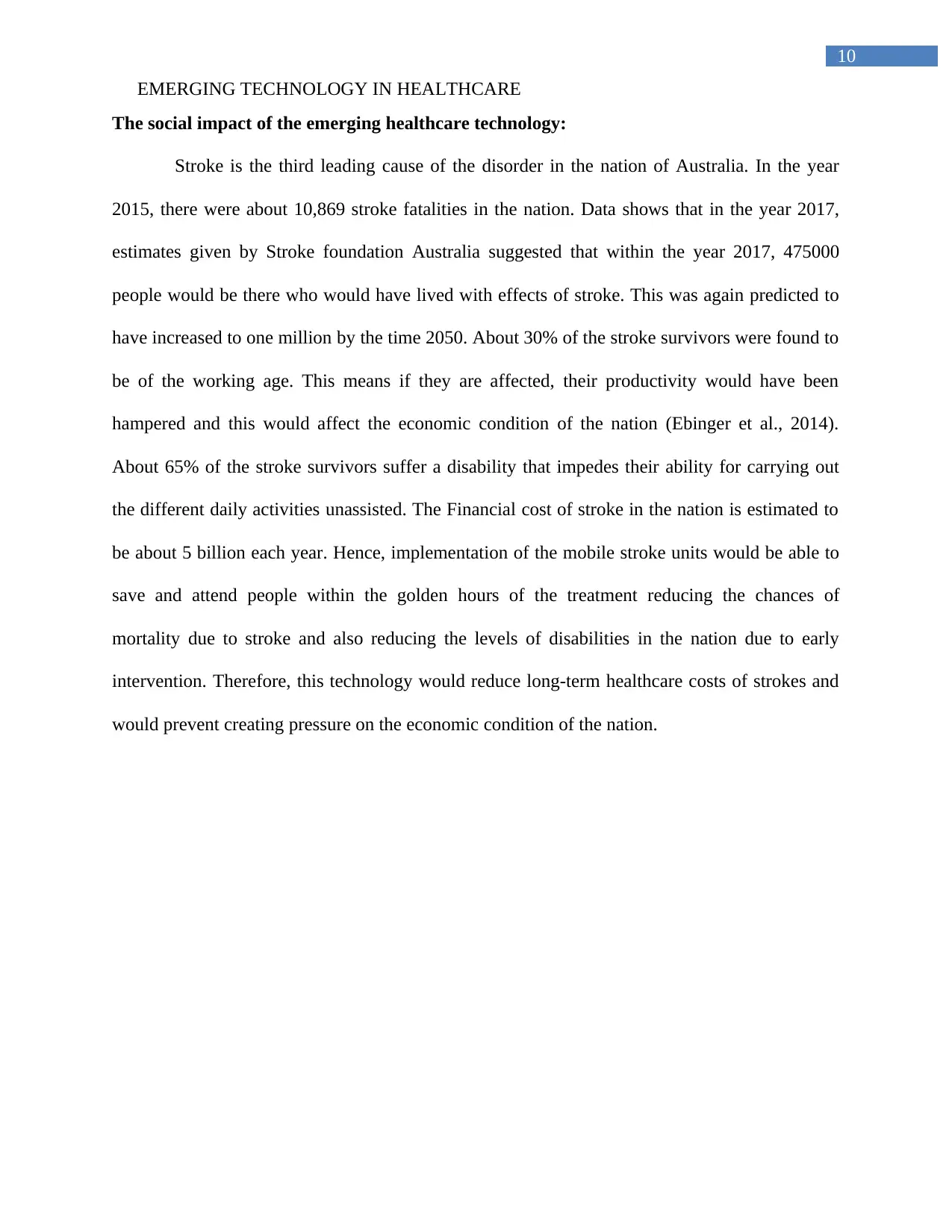
10
EMERGING TECHNOLOGY IN HEALTHCARE
The social impact of the emerging healthcare technology:
Stroke is the third leading cause of the disorder in the nation of Australia. In the year
2015, there were about 10,869 stroke fatalities in the nation. Data shows that in the year 2017,
estimates given by Stroke foundation Australia suggested that within the year 2017, 475000
people would be there who would have lived with effects of stroke. This was again predicted to
have increased to one million by the time 2050. About 30% of the stroke survivors were found to
be of the working age. This means if they are affected, their productivity would have been
hampered and this would affect the economic condition of the nation (Ebinger et al., 2014).
About 65% of the stroke survivors suffer a disability that impedes their ability for carrying out
the different daily activities unassisted. The Financial cost of stroke in the nation is estimated to
be about 5 billion each year. Hence, implementation of the mobile stroke units would be able to
save and attend people within the golden hours of the treatment reducing the chances of
mortality due to stroke and also reducing the levels of disabilities in the nation due to early
intervention. Therefore, this technology would reduce long-term healthcare costs of strokes and
would prevent creating pressure on the economic condition of the nation.
EMERGING TECHNOLOGY IN HEALTHCARE
The social impact of the emerging healthcare technology:
Stroke is the third leading cause of the disorder in the nation of Australia. In the year
2015, there were about 10,869 stroke fatalities in the nation. Data shows that in the year 2017,
estimates given by Stroke foundation Australia suggested that within the year 2017, 475000
people would be there who would have lived with effects of stroke. This was again predicted to
have increased to one million by the time 2050. About 30% of the stroke survivors were found to
be of the working age. This means if they are affected, their productivity would have been
hampered and this would affect the economic condition of the nation (Ebinger et al., 2014).
About 65% of the stroke survivors suffer a disability that impedes their ability for carrying out
the different daily activities unassisted. The Financial cost of stroke in the nation is estimated to
be about 5 billion each year. Hence, implementation of the mobile stroke units would be able to
save and attend people within the golden hours of the treatment reducing the chances of
mortality due to stroke and also reducing the levels of disabilities in the nation due to early
intervention. Therefore, this technology would reduce long-term healthcare costs of strokes and
would prevent creating pressure on the economic condition of the nation.
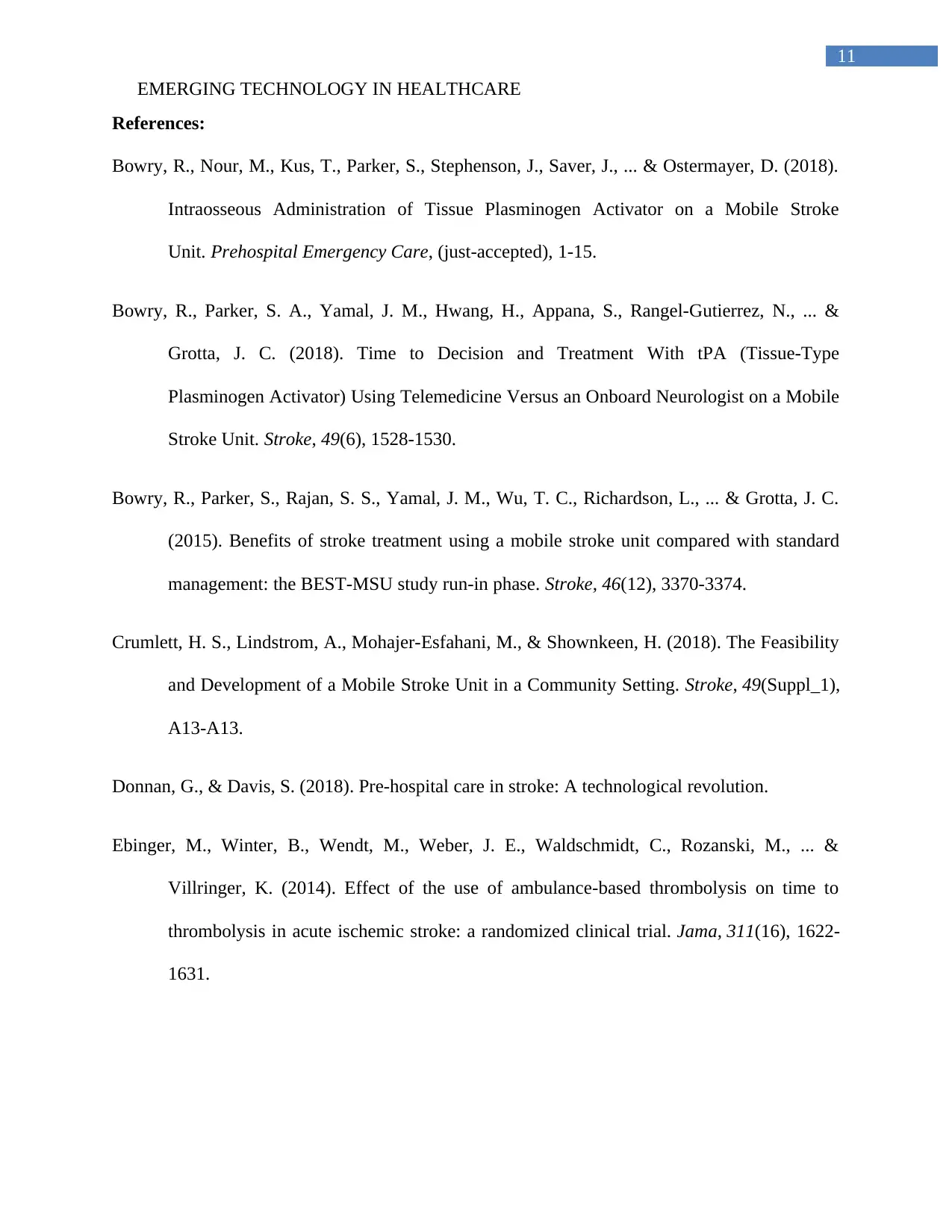
11
EMERGING TECHNOLOGY IN HEALTHCARE
References:
Bowry, R., Nour, M., Kus, T., Parker, S., Stephenson, J., Saver, J., ... & Ostermayer, D. (2018).
Intraosseous Administration of Tissue Plasminogen Activator on a Mobile Stroke
Unit. Prehospital Emergency Care, (just-accepted), 1-15.
Bowry, R., Parker, S. A., Yamal, J. M., Hwang, H., Appana, S., Rangel-Gutierrez, N., ... &
Grotta, J. C. (2018). Time to Decision and Treatment With tPA (Tissue-Type
Plasminogen Activator) Using Telemedicine Versus an Onboard Neurologist on a Mobile
Stroke Unit. Stroke, 49(6), 1528-1530.
Bowry, R., Parker, S., Rajan, S. S., Yamal, J. M., Wu, T. C., Richardson, L., ... & Grotta, J. C.
(2015). Benefits of stroke treatment using a mobile stroke unit compared with standard
management: the BEST-MSU study run-in phase. Stroke, 46(12), 3370-3374.
Crumlett, H. S., Lindstrom, A., Mohajer-Esfahani, M., & Shownkeen, H. (2018). The Feasibility
and Development of a Mobile Stroke Unit in a Community Setting. Stroke, 49(Suppl_1),
A13-A13.
Donnan, G., & Davis, S. (2018). Pre-hospital care in stroke: A technological revolution.
Ebinger, M., Winter, B., Wendt, M., Weber, J. E., Waldschmidt, C., Rozanski, M., ... &
Villringer, K. (2014). Effect of the use of ambulance-based thrombolysis on time to
thrombolysis in acute ischemic stroke: a randomized clinical trial. Jama, 311(16), 1622-
1631.
EMERGING TECHNOLOGY IN HEALTHCARE
References:
Bowry, R., Nour, M., Kus, T., Parker, S., Stephenson, J., Saver, J., ... & Ostermayer, D. (2018).
Intraosseous Administration of Tissue Plasminogen Activator on a Mobile Stroke
Unit. Prehospital Emergency Care, (just-accepted), 1-15.
Bowry, R., Parker, S. A., Yamal, J. M., Hwang, H., Appana, S., Rangel-Gutierrez, N., ... &
Grotta, J. C. (2018). Time to Decision and Treatment With tPA (Tissue-Type
Plasminogen Activator) Using Telemedicine Versus an Onboard Neurologist on a Mobile
Stroke Unit. Stroke, 49(6), 1528-1530.
Bowry, R., Parker, S., Rajan, S. S., Yamal, J. M., Wu, T. C., Richardson, L., ... & Grotta, J. C.
(2015). Benefits of stroke treatment using a mobile stroke unit compared with standard
management: the BEST-MSU study run-in phase. Stroke, 46(12), 3370-3374.
Crumlett, H. S., Lindstrom, A., Mohajer-Esfahani, M., & Shownkeen, H. (2018). The Feasibility
and Development of a Mobile Stroke Unit in a Community Setting. Stroke, 49(Suppl_1),
A13-A13.
Donnan, G., & Davis, S. (2018). Pre-hospital care in stroke: A technological revolution.
Ebinger, M., Winter, B., Wendt, M., Weber, J. E., Waldschmidt, C., Rozanski, M., ... &
Villringer, K. (2014). Effect of the use of ambulance-based thrombolysis on time to
thrombolysis in acute ischemic stroke: a randomized clinical trial. Jama, 311(16), 1622-
1631.
⊘ This is a preview!⊘
Do you want full access?
Subscribe today to unlock all pages.

Trusted by 1+ million students worldwide
1 out of 14
Related Documents
Your All-in-One AI-Powered Toolkit for Academic Success.
+13062052269
info@desklib.com
Available 24*7 on WhatsApp / Email
![[object Object]](/_next/static/media/star-bottom.7253800d.svg)
Unlock your academic potential
Copyright © 2020–2025 A2Z Services. All Rights Reserved. Developed and managed by ZUCOL.




